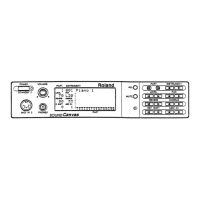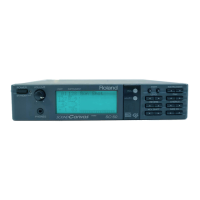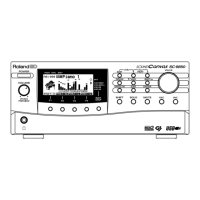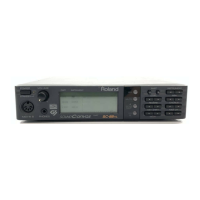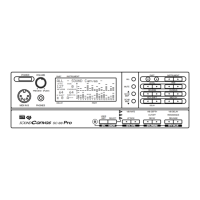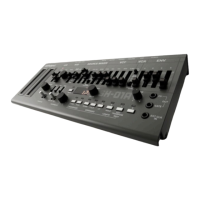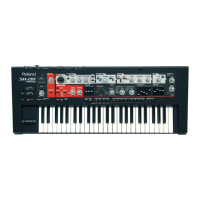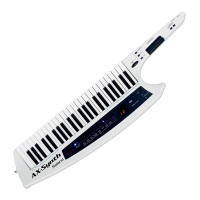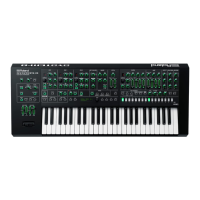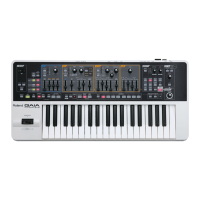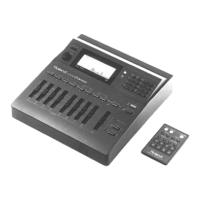
Do you have a question about the Roland Sound Canvas SC-155 and is the answer not in the manual?
| Type | Synthesizer |
|---|---|
| MIDI Channels | 16 |
| Multitimbral | 16-part |
| Effects | Reverb, Chorus |
| MIDI | In, Out, Thru |
| Power Supply | AC adapter |
| Sound Generation | PCM |
| Waveforms | PCM |
| Outputs | Stereo |
| Connections | MIDI |
Explains safe usage and connection of the power adapter for the unit.
Advises on suitable locations for operating the unit, avoiding hazards.
Provides guidance on cleaning and caring for the Sound Canvas unit.
Lists essential safety warnings to prevent damage or injury.
Details the battery backup function and its implications for data retention.
Identifies and explains the controls and indicators on the unit's front panel.
Details the input/output jacks and connectors located on the rear panel.
Diagram and description of the connectors and ports on the rear panel.
Explains the MIDI IN and OUT connectors for data communication.
Details on connecting audio sources to the unit's output and input jacks.
Instructions for connecting headphones and the AC adapter for power.
Step-by-step guide on how to safely turn on the Sound Canvas unit.
Instructions on the correct sequence for turning off the unit and connected equipment.
Initial steps required before operating the remote control unit.
Details the functionality of each button on the remote control for unit operation.
Instructions for replacing the battery in the remote control unit.
Steps to activate and listen to the built-in demonstration song.
How to stop the demo song playback and return to normal status.
Introduction to selecting and playing different instrument sounds on the unit.
Step-by-step guide for selecting and changing instrument sounds.
How to adjust the volume level for individual parts and the overall unit.
How to adjust the stereo pan position for individual parts and the overall unit.
Guide on modifying the reverb effect level to add spaciousness to the sound.
Instructions for adjusting the chorus effect level for sound depth and warmth.
Procedure for changing the pitch of notes in semitone steps or octaves.
Explains how parts correspond to MIDI channels and instruments in the Sound Canvas.
Step-by-step guide for selecting and changing instrument sounds.
How to change instruments on the Sound Canvas via an external MIDI keyboard.
Explains the drum set function and its relation to percussion sounds and MIDI channels.
Steps for selecting and changing the drum set using the unit's controls.
How to change drum sets on the Sound Canvas via an external MIDI device.
Procedure for selecting instruments using the PART/INST buttons for quick access.
How to save favorite instrument settings to the PART/INST buttons for quick recall.
Explains the function of parameters like Level, Pan, Reverb, Chorus, and Key Shift.
General steps for accessing and adjusting various part-specific settings.
How to adjust volume levels for individual parts and the entire unit using sliders.
How to adjust stereo pan position for parts and the entire instrument using sliders.
How to store and recall custom instrument, volume, and pan settings for each part.
Procedure for saving current settings as user presets or clearing them.
How to temporarily silence all parts of the Sound Canvas simultaneously.
How to mute individual parts of the Sound Canvas to isolate sounds.
Ensures the mute setting remains active even after a GS reset message.
How to listen to the sound of a single specified part for monitoring purposes.
How to listen to the sound of all parts simultaneously for overall monitoring.
Guide on muting a part and playing along with the remaining parts.
Procedure for assigning specific parts to control sliders for parameter adjustment.
How to adjust the master pitch of the Sound Canvas to match other instruments.
How to make fine adjustments to the pitch for precise tuning.
Steps to adjust the LCD screen contrast for better visibility.
Explanation of the different display modes for visualizing audio levels.
Procedure for selecting the desired display mode for the unit's level indicators.
Procedure for saving current instrument and parameter settings to memory.
Procedure for loading previously stored instrument and parameter settings.
Describes initial settings for the MT-32 sound arrangement and compatibility.
Highlights key differences when using the Sound Canvas with an MT-32 arrangement.
Procedure for setting the unit to its basic GS format configuration.
Explains how to toggle the GS reset function for factory preset restoration.
Procedure for resetting all settings to their original factory defaults.
Details the backup switch function for saving previous settings.
Procedure for setting the MIDI receive channel for each part of the unit.
Explains the different reverb types available and how to select them.
Details the various chorus types and the procedure for selecting them.
Step-by-step guide for selecting desired reverb and chorus effect types.
How to adjust the pitch bend range for instruments.
How to adjust the depth of the modulation effect for vibrato-like characteristics.
How to define the range of notes for specific instruments or parts.
Adjusts how note velocity affects volume, with higher values increasing sensitivity.
Covers M/P mode, Portamento, and Modulation settings for sound output.
Controls the intensity of expression, similar to volume but for subtle changes.
Discusses the maximum number of notes that can sound simultaneously.
Details the order in which notes are prioritized and potentially cut when polyphony is exceeded.
Explains the function that reserves a minimum number of voices for each part.
Describes how instrument variations add different nuances to sounds.
Details how instrument variations are applied based on instrument number.
Explains variations for special effect sounds and their assignment.
Describes the concept of Sub Capital variations and their assignment.
Step-by-step guide for selecting and changing instrument variations.
How to change instruments on the Sound Canvas via an external MIDI device.
Ensures instrument changes via MIDI are handled correctly.
Adjusts vibrato effect parameters like rate, depth, and delay time.
Covers parameters affecting sound character like Cutoff Frequency and Resonance.
Details envelope parameters: Attack Time, Decay Time, and Release Time.
General procedure for accessing and adjusting various sound parameters.
Explains how to transmit basic parameters and mute settings to a sequencer.
Procedure for transmitting all parts or specified part settings to a sequencer.
How to transmit volume level and pan settings as MIDI messages.
How to transmit mute status as MIDI exclusive messages.
Procedure for transmitting instrument assignments to a sequencer.
Procedure for transmitting volume level and pan settings to a sequencer.
Details how to set parameters like Modulation, Expression, etc., for MIDI transmission.
Procedure for transmitting all Sound Canvas settings to a sequencer.
Procedure for transmitting all parts or specific part settings to a sequencer.
Procedure for transmitting settings of a single specified part to a sequencer.
Procedure for receiving data from a sequencer into the Sound Canvas.
Details on changing the Device ID for proper MIDI communication.
Common problems and solutions for operating the Sound Canvas unit.
List of possible error messages and their causes or actions.
Explanation of MIDI concepts, connectors, and messages used by the unit.
Overview of the GS format and its features in relation to the Sound Canvas.
A reference table summarizing functions, parameters, and their page numbers.
A comprehensive list of all available instrument sounds and their program numbers.
A table detailing the available drum sets and their associated sounds.
Technical chart detailing MIDI messages transmitted and recognized by the unit.
Technical specifications and dimensions of the Sound Canvas SC-155.
